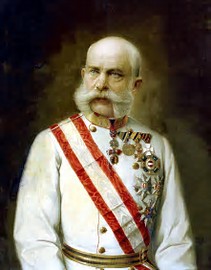My latest novel – Wrath of the Ancients – is largely set in Vienna, Austria’s imperial capital and surely one of the most beautiful and enchanting cities in the world. Its streets team with culture and its proud residents are almost fiercely protective of their enigmatic, sometimes quirky, and endlessly fascinating home, where everyone from Strauss to Klimt and Freud lived and worked. Some of them have never left, and today, I am going to tell you about one in particular. A beautiful and ultimately tragic Empress.
Her family called her Sisi and if you visit Vienna today you will see her image everywhere. Frequently referred to as ‘Austria’s Princess Diana’ and ‘Empress of Hearts’, as she championed the causes of the underprivileged – Empress Elisabeth was born in Bavaria of minor nobility in a family notorious for its inbreeding. In fact she carried on this trait by marrying her first cousin – Emperor Franz Josef.
As a child in the picturesque countryside of Possenhofen, Sisi had largely run wild. An accomplished horsewoman with a love of large dogs, she was ill-prepared for the most staid and clinically ordered royal court in Europe. From the beginning of her marriage, she managed to upset almost every courtier she came into contact with, simply by trying to be herself. There had been little money in her branch of the family and to be told she could only wear an item of clothing – such as shoes – once seemed wanton extravagance. Sisi grew increasingly unhappy and took to spending months at a time, away from the strictures of the Vienna court, overseas in Madeira or Corfu. Her life contained much sadness. Her husband adored her, but his love was barely reciprocated. She was subject to extreme bouts of depression and the death of her son, probably at his own hand, nearly destroyed her. The knowledge that he had almost certainly shot his mistress before shooting himself only made the grief worse.
Sisi exercised rigorously and ate a strictly limited diet in order to retain her slender waist. Her crowning glory was her hair and, it seems the Empress, who was assassinated by a revolutionary in 1898, still prides herself on her magnificent coiffure from beyond the grave.
Recently, an employee at the Schönbrunn Palace had the shock of his life when he walked through the Empress’s dressing room only to see her, having her hair combed by her favourite lady’s maid, Fanny Feiflik. It seems he is not the only person to have seen the sad figure. Why she would choose to haunt a place where she experienced so much heartbreak and animosity is unclear. Maybe she doesn’t have a choice. Maybe it is her husband who calls her back.
Emperor Franz Josef did everything he could to keep his wife by his side. To try and entice her to stay in Austria, he built an idyllic rural mansion for her in the woods on the outskirts of Vienna, but she spent little time there. It wasn’t long before the wanderlust took hold and she sailed off again. Bowing to the inevitable, when Corfu became her favoured destination, the Emperor had a palace built for her in the classical Greek style of her choice. He could deny her nothing – especially since their son had just died.
Franz Josef too has been seen in the grounds of the Schönbrunn, strolling in the Tiergarten as was his wont in life. Perhaps he still hopes he will see his beloved wife.
Theirs are not the only ghosts to haunt the palace. There is the (perhaps inevitable) White Lady whose identity is unknown and there is also a former lady in waiting to Empress Maria Theresia. Countess Maria Wilhelmina von Auersperg was another unhappy lady. She caught the eye of Maria Theresia’s husband – Emperor Franz Stefan I – and the two embarked on an affair. Needless to say when the Empress learned of their illicit meetings, she ensured the Countess was married off quickly and, as a result, made to leave court. The marriage was an unfortunate one and the Countess died, unhappy and unfulfilled, at the age of 37. She has been seen on a number of occasions, hovering around the gardens.
Most of the ghosts of Schönbrunn are reclusive and prefer only to appear after the tourists have gone home in the evening but if you visit there you can learn more of the secrets of the magnificent gardens which were said to have bene planned using heavy masonic symbolism. If you visit the pavilion in the centre of the gardens, now a cafe, you will be standing above the cellars where Emperor Franz Stefan is alleged to have had his alchemist laboratory. Who knows what he conjured up there?
 Egypt, 1908
Egypt, 1908
Eminent archaeologist Dr. Emeryk Quintillus has unearthed the burial chamber of Cleopatra. But this tomb raider’s obsession with the Queen of the Nile has nothing to do with preserving history. Stealing sacred and priceless relics, he murders his expedition crew, and flees—escaping the quake that swallows the site beneath the desert sands . . .
Vienna, 1913
Young widow Adeline Ogilvy has accepted employment at the mansion of Dr. Quintillus, transcribing the late professor’s memoirs. Within the pages of his journals, she discovers the ravings of a madman convinced he possessed the ability to reincarnate Cleopatra. Within the walls of his home, she is assailed by unexplained phenomena: strange sounds, shadowy figures, and apparitions of hieroglyphics.
Something pursued Dr. Quintillus from Egypt. Something dark, something hungry. Something tied to the fate and future of Adeline Ogilvy . . .
Buy links:
Amazon
Nook
Apple
Google
Kobo
Author Bio
Following a varied career in sales, advertising and career guidance, Catherine Cavendish is now the full-time author of a number of paranormal, ghostly and Gothic horror novels, novellas and short stories. Cat’s novels include the Nemesis of the Gods trilogy – Wrath of the Ancients, Waking the Ancients and Damned by the Ancients, plus The Devil’s Serenade, The Pendle Curse, Saving Grace Devine and many more. She lives with her long-suffering husband, and a black cat who has never forgotten that her species used to be worshipped in ancient Egypt. She sees no reason why that practice should not continue. Cat and her family divide their time between Liverpool and a 260-year-old haunted apartment in North Wales.
Author Links
Website: http://www.catherinecavendish.com/
Twitter: https://twitter.com/Cat_Cavendish
Facebook: https://www.facebook.com/CatherineCavendishWriter?fref=ts






 Uncover the Truth With These New Mystery Series
Uncover the Truth With These New Mystery Series